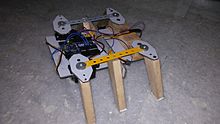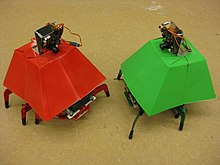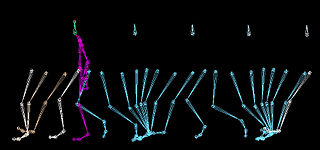
Walking is one of the main gaits of terrestrial locomotion among legged animals. Walking is typically slower than running and other gaits. Walking is defined by an 'inverted pendulum' gait in which the body vaults over the stiff limb or limbs with each step. This applies regardless of the usable number of limbs—even arthropods, with six, eight, or more limbs, walk. In humans, walking has health benefits including improved mental health and reduced risk of cardiovascular disease and death.
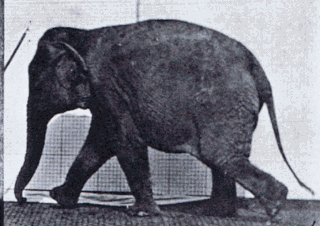
Gait is the pattern of movement of the limbs of animals, including humans, during locomotion over a solid substrate. Most animals use a variety of gaits, selecting gait based on speed, terrain, the need to maneuver, and energetic efficiency. Different animal species may use different gaits due to differences in anatomy that prevent use of certain gaits, or simply due to evolved innate preferences as a result of habitat differences. While various gaits are given specific names, the complexity of biological systems and interacting with the environment make these distinctions "fuzzy" at best. Gaits are typically classified according to footfall patterns, but recent studies often prefer definitions based on mechanics. The term typically does not refer to limb-based propulsion through fluid mediums such as water or air, but rather to propulsion across a solid substrate by generating reactive forces against it.
BEAM robotics is a style of robotics that primarily uses simple analogue circuits, such as comparators, instead of a microprocessor in order to produce an unusually simple design. While not as flexible as microprocessor based robotics, BEAM robotics can be robust and efficient in performing the task for which it was designed.
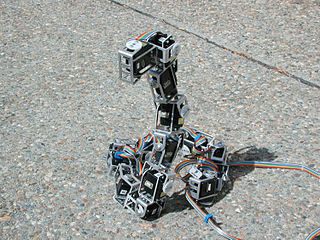
The SnakeBot, also known as a snake robot, is a biomorphic hyper-redundant robot that resembles a biological snake. Snake robots come in many shapes and sizes, from as long as four stories to a medical SnakeBot developed at Carnegie Mellon University that is thin enough to maneuver around organs inside a human chest cavity. Though SnakeBots can very greatly in size and design, there are two qualities that all SnakeBot share. The small cross-section-to-length ratios allow them to move into and maneuver through tight spaces and their ability to change the shape of their bodies allows them to perform a wide range of behaviors, such as climbing stairs or tree trunks. Additionally, many snake robots are constructed by chaining together several independent links. This redundancy can make them resistant to failure because they can continue to operate even if parts of their body are destroyed. Properties such as high terrainability, redundancy, and the possibility of complete sealing of the body of the robot, make snake robots very interesting for practical applications and hence as a research topic. A SnakeBot is different from a snake-arm robot in that the SnakeBot robot types are usually more self-contained, where a snake-arm robot usually has remote mechanicals from the arm itself, possibly connected to a larger system.
Robot locomotion is the collective name for the various methods that robots use to transport themselves from place to place.

A mobile robot is an automatic machine that is capable of locomotion. Mobile robotics is usually considered to be a subfield of robotics and information engineering.

Terrestrial locomotion has evolved as animals adapted from aquatic to terrestrial environments. Locomotion on land raises different problems than that in water, with reduced friction being replaced by the increased effects of gravity.
The bow leg is a highly resilient robotic leg being developed for running robots at Carnegie Mellon University's Robotics Institute. The key technology is the fiber-reinforced composite (FRC) spring that bends like a bow to store elastic energy.

Tripedalism is locomotion by the use of three limbs. It has been said that parrots (Psittaciformes) display tripedalism during climbing gaits, which was tested and proven in a 2022 paper on the subject, making parrots the only creatures to truly use tripedal forms of locomotion. Tripedal gaits were also observed by K. Hunt in primates. This is usually observed when the animal is using one limb to grasp a carried object and is thus a non-standard gait. Apart from climbing in parrots, there are no known animal behaviours where the same three extremities are routinely used to contact environmental supports, although the movement of some macropods such as kangaroos, which can alternate between resting their weight on their muscular tails and their two hind legs and hop on all three, may be an example of tripedal locomotion in animals. There are also the tripod fish. Several species of these fish rest on the ocean bottom on two rays from their two pelvic fins and one ray from their caudal fin.
Modular self-reconfiguring robotic systems or self-reconfigurable modular robots are autonomous kinematic machines with variable morphology. Beyond conventional actuation, sensing and control typically found in fixed-morphology robots, self-reconfiguring robots are also able to deliberately change their own shape by rearranging the connectivity of their parts, in order to adapt to new circumstances, perform new tasks, or recover from damage.

Legged robots are a type of mobile robot which use articulated limbs, such as leg mechanisms, to provide locomotion. They are more versatile than wheeled robots and can traverse many different terrains, though these advantages require increased complexity and power consumption. Legged robots often imitate legged animals, such as humans or insects, in an example of biomimicry.

RHex is an autonomous robot design, based on hexapod with compliant legs and one actuator per leg. A number of US universities have participated, with funding grants also coming from DARPA.

Robotics is the branch of technology that deals with the design, construction, operation, structural disposition, manufacture and application of robots. Robotics is related to the sciences of electronics, engineering, mechanics, and software.
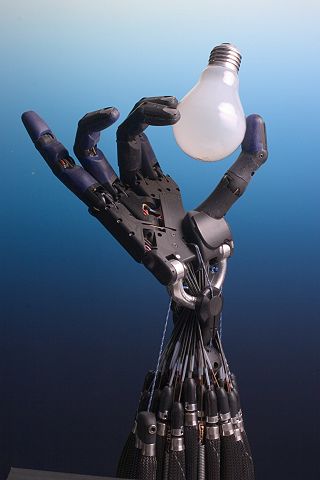
Robotics is an interdisciplinary field that involves the design, construction, operation, and use of robots.

Undulatory locomotion is the type of motion characterized by wave-like movement patterns that act to propel an animal forward. Examples of this type of gait include crawling in snakes, or swimming in the lamprey. Although this is typically the type of gait utilized by limbless animals, some creatures with limbs, such as the salamander, forgo use of their legs in certain environments and exhibit undulatory locomotion. In robotics this movement strategy is studied in order to create novel robotic devices capable of traversing a variety of environments.
The following outline is provided as an overview of and topical guide to robotics:

LAURON is a six-legged walking robot, which is being developed at the FZI Forschungszentrum Informatik in Germany. The mechanics and the movements of the robot are biologically-inspired, mimicking the stick insect Carausius Morosus. The development of the LAURON walking robot started with basic research in field of six-legged locomotion in the early 1990s and led to the first robot, called LAURON. In the year 1994, this robot was presented to public at the CeBIT in Hanover. This first LAURON generation was, in contrast to the current generation, controlled by an artificial neural network, hence the robot's German name: LAUfROboter Neuronal gesteuert. The current generation LARUON V was finished in 2013.

Bio-inspired robotic locomotion is a fairly new subcategory of bio-inspired design. It is about learning concepts from nature and applying them to the design of real-world engineered systems. More specifically, this field is about making robots that are inspired by biological systems, including Biomimicry. Biomimicry is copying from nature while bio-inspired design is learning from nature and making a mechanism that is simpler and more effective than the system observed in nature. Biomimicry has led to the development of a different branch of robotics called soft robotics. The biological systems have been optimized for specific tasks according to their habitat. However, they are multifunctional and are not designed for only one specific functionality. Bio-inspired robotics is about studying biological systems, and looking for the mechanisms that may solve a problem in the engineering field. The designer should then try to simplify and enhance that mechanism for the specific task of interest. Bio-inspired roboticists are usually interested in biosensors, bioactuators, or biomaterials. Most of the robots have some type of locomotion system. Thus, in this article different modes of animal locomotion and few examples of the corresponding bio-inspired robots are introduced.
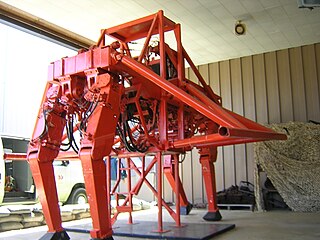
A walking vehicle is a vehicle that moves on legs rather than wheels or tracks. Walking vehicles have been constructed with anywhere from one to more than eight legs. There are many designs for the leg mechanisms of walking machines that provide foot trajectories with different properties.
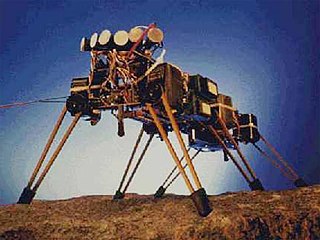
An insectoid robot is a, usually small, robot featuring some insect-like features. These can include the methods of locomotion, methods of navigation, and artificial intelligence based on insect models. Many of the problems faced by miniature robot designers have been solved by insect evolution. Researchers naturally look to insects for inspiration and solutions.
